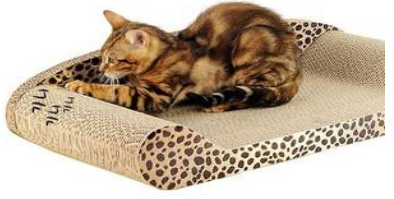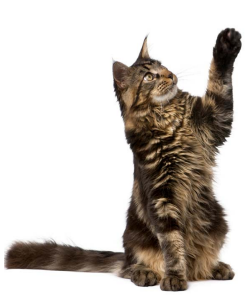Training Cats with Positive Reinforcement
Training your cat has many important benefits including stimulating their body/mind, which helps keep them healthy while strengthening the bond you share by spending more quality time together.
Reward behaviors that you want
Simply put, if you want your cat to repeat a behavior, reward that behavior. It’s important to make sure that you’re rewarding the behavior you want and not accidentally rewarding an unwanted behavior. For example: when your cat meows at you, do you talk back to them or give a treat? This is serving to teach them that if they meow at you, they get a treat. If you don’t reward meowing — in other words, ignore them when they meow — they’re unlikely to become a meower. If you really like a quiet cat, reward when they’re not meowing.
Use rewards to teach new behaviors
If you’d like your cat to come to you when you call try this: Call their name and reward with a treat when they walk over to you. Move to another spot, call their name, and reward when they respond.
Provide the right motivation
Motivation is the key to training. For the majority of cats, this will likely be treats in the form of food, but some find play or praise incredibly motivating. It all depends on the cat! It can take some trial and error, but finding the right motivator for your cat will be the most important factor.
High-value rewards
Some cats find commercial kitty treats, tuna or a small amount of wet food highly rewarding, while others may not be as food-motivated and may need something novel or of higher value. Here are some novel treats to try with your cat:
(Remember, small bites are all they need – everything in moderation!)
- Whipped cream
- Easy cheese (yes, cheese in a can!)
- Meat-flavored baby food
- Cut-up pieces of hot dog or cooked chicken
If your cat has difficulty taking treats from your fingers, try offering it in your flat palm or tossing it on the floor.
Reward immediately and consistently
Timing is everything in training your cat. The reward must come immediately (within seconds) of the behavior or your cat may not know what it’s for. Give the reward each time your cat behaves the way you want them to, and make sure everyone in the family does the same.
(Eventually) trade in the treats
Because too many treats can lead to an overweight cat, your goal is to gradually wean them off the constant food rewards and trade for emotional ones such as a “good kitty,” or a scratch under the chin. Once your cat is displaying the desired behavior reliably, slowly start cutting back on food rewards. Give treats three out of every four times they do the desired behavior, then reduce it to about half the time, then about a third of the time and so on, until you’re only using food rewards occasionally. Don’t forget to always give praise and other non-food rewards!
Never punish
Punishing cats just doesn’t work. Positive reinforcement is the best way to help cats establish better habits in your home. It’s fun to reward your cat for desirable behavior, and it improves the strength of your bond. The more often you can reward behavior with a motivator your cat enjoys, the more often you will see that behavior repeated. On the other hand, punishment in any form (e.g. yelling, hitting, using a squirt bottle, tossing objects directly at your cat) is ineffective. What do you think will happen to the relationship you have with your cat if you’re punishing them all the time? They’ll start to mistrust and fear you, which can result in aggression. Punishment will only serve to damage the cat-human relationship, and that’s not what you want. Cats respond so much better to positive reinforcement!
Ways you can apply positive reinforcement every day
Here are a few ways you can use positive reinforcement to make changes to your cat’s daily behaviors (these are just examples, but positive reinforcement can apply to nearly any behavior you’d like to encourage).
Use a Scratching Post/Pad: You can encourage regular use of your cat’s scratcher by rewarding them every time they use it. They’ll learn to associate using the scratcher with getting rewarded, encouraging them to use it more often.

Encourage Social Behavior: If your cat is shy and has a tendency to hide, you can encourage them using treats to reward them when they emerge from their hiding spot. At first keep these ventures brief, and as they become more comfortable and willing, use more positive reinforcement to encourage further travel from their hiding spot for longer periods of time.
Teach Your Cat to Accept/Enjoy Grooming: If your cat doesn’t like to be brushed, give them a treat for one touch of the brush, then twice and give another treat. Reward longer sessions with more treats, and stop the sessions before your cat has a negative reaction. Pay attention to their body language and always end on a positive note!
Reward Quiet or Calm Behavior: If you’ve been having issues with your cat yowling or being aggressive with another cat, you can reward good behavior using treats or play. If excessive vocalization is a problem, give your cat a treat after several seconds of quiet if they have been meowing. If they’re aggressive towards another cat in your home, reward when they are relaxed and peaceful in the presence of the other cat.

TRICKS!: You can teach your cat all sorts of tricks using positive reinforcement: sit, high-five, sit pretty, wave, lay down, come, up, down, jump, etc. The possibilities are endless!